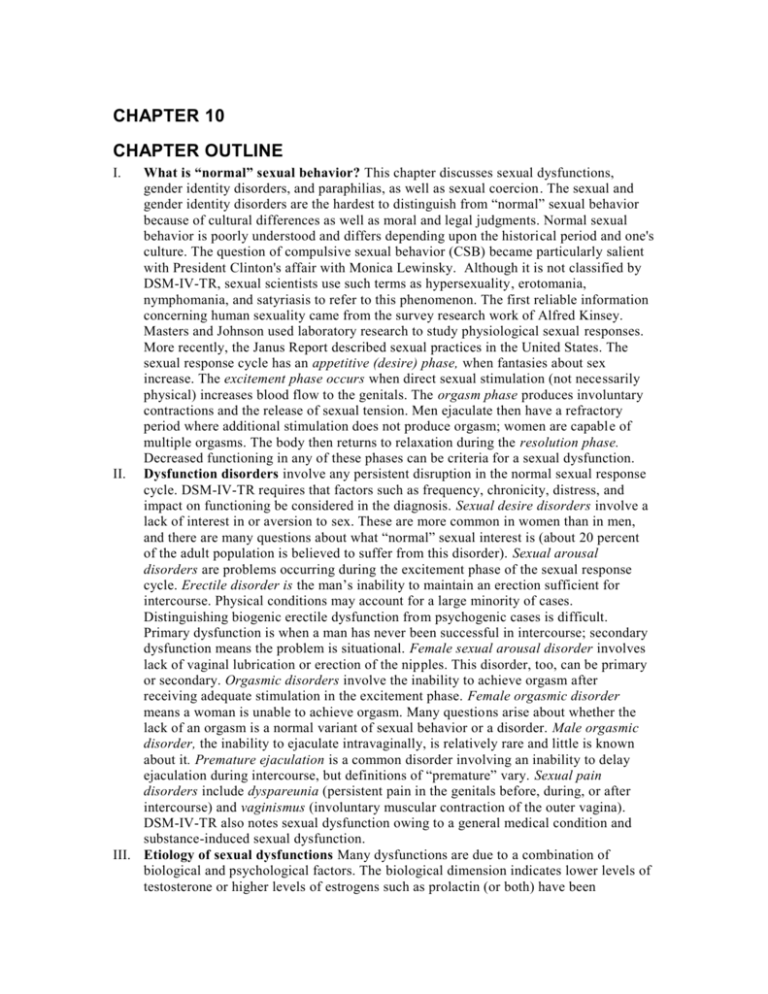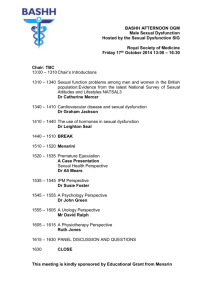
CHAPTER 10
CHAPTER OUTLINE
What is “normal” sexual behavior? This chapter discusses sexual dysfunctions,
gender identity disorders, and paraphilias, as well as sexual coercion. The sexual and
gender identity disorders are the hardest to distinguish from “normal” sexual behavior
because of cultural differences as well as moral and legal judgments. Normal sexual
behavior is poorly understood and differs depending upon the historical period and one's
culture. The question of compulsive sexual behavior (CSB) became particularly salient
with President Clinton's affair with Monica Lewinsky. Although it is not classified by
DSM-IV-TR, sexual scientists use such terms as hypersexuality, erotomania,
nymphomania, and satyriasis to refer to this phenomenon. The first reliable information
concerning human sexuality came from the survey research work of Alfred Kinsey.
Masters and Johnson used laboratory research to study physiological sexual responses.
More recently, the Janus Report described sexual practices in the United States. The
sexual response cycle has an appetitive (desire) phase, when fantasies about sex
increase. The excitement phase occurs when direct sexual stimulation (not necessarily
physical) increases blood flow to the genitals. The orgasm phase produces involuntary
contractions and the release of sexual tension. Men ejaculate then have a refractory
period where additional stimulation does not produce orgasm; women are capable of
multiple orgasms. The body then returns to relaxation during the resolution phase.
Decreased functioning in any of these phases can be criteria for a sexual dysfunction.
II. Dysfunction disorders involve any persistent disruption in the normal sexual response
cycle. DSM-IV-TR requires that factors such as frequency, chronicity, distress, and
impact on functioning be considered in the diagnosis. Sexual desire disorders involve a
lack of interest in or aversion to sex. These are more common in women than in men,
and there are many questions about what “normal” sexual interest is (about 20 percent
of the adult population is believed to suffer from this disorder). Sexual arousal
disorders are problems occurring during the excitement phase of the sexual response
cycle. Erectile disorder is the man’s inability to maintain an erection sufficient for
intercourse. Physical conditions may account for a large minority of cases.
Distinguishing biogenic erectile dysfunction from psychogenic cases is difficult.
Primary dysfunction is when a man has never been successful in intercourse; secondary
dysfunction means the problem is situational. Female sexual arousal disorder involves
lack of vaginal lubrication or erection of the nipples. This disorder, too, can be primary
or secondary. Orgasmic disorders involve the inability to achieve orgasm after
receiving adequate stimulation in the excitement phase. Female orgasmic disorder
means a woman is unable to achieve orgasm. Many questions arise about whether the
lack of an orgasm is a normal variant of sexual behavior or a disorder. Male orgasmic
disorder, the inability to ejaculate intravaginally, is relatively rare and little is known
about it. Premature ejaculation is a common disorder involving an inability to delay
ejaculation during intercourse, but definitions of “premature” vary. Sexual pain
disorders include dyspareunia (persistent pain in the genitals before, during, or after
intercourse) and vaginismus (involuntary muscular contraction of the outer vagina).
DSM-IV-TR also notes sexual dysfunction owing to a general medical condition and
substance-induced sexual dysfunction.
III. Etiology of sexual dysfunctions Many dysfunctions are due to a combination of
biological and psychological factors. The biological dimension indicates lower levels of
testosterone or higher levels of estrogens such as prolactin (or both) have been
I.
associated with lower sexual interest in both men and women and with erectile
difficulties in men The psychological dimension understand that sexual dysfunctions
may be due to psychological factors alone or to a combination of psychological and
biological factors The social dimension examines social upbringing and current
relationships as important in sexual functioning. It seems plausible that the attitudes
parents display toward sex and affection and toward each other can influence their
children’s attitudes The sociocultural dimensions makes it clear that sexual behavio r
and functioning are influenced by gender, age, cultural scripts, educational level, and
country of origin. While the human sexual response cycle is similar for women and
men, gender differences are clearly present: women (1) are capable of multiple orgas ms,
(2) entertain different sexual fantasies than men, (3) have a broader arousal pattern to
sexual stimuli, (4) are more attuned to relationships in the sexual encounter, and (5) take
longer than men to become aroused.
IV. Treatment of Sexual Dysfunction. Biological dimension uses treatments including
exercise, oral medication (Viagra), surgery, and injections into the penis of substances
that induce erection. Psychological treatments includes predisposing causes, such as
early experiences and upbringing, and current concerns, such as poor marital relations
and performance anxiety. Research shows that anxiety and self-focus impair
performance. Treatment often includes education, anxiety reduction, structured
behavioral exercises, and improved communication. Specific treatments for
dysfunctions include masturbation as treatment for female orgasmic disorder, the
“squeeze technique” for premature ejaculation, and relaxation and insertion of dilators
for vaginismus.
V. Homosexuality. The American Psychological Association no longer consider
homosexuality to be a mental disorder, however some individuals still harbor this belief.
Homosexuality is not a mental disorder. There are no physiological differences in
sexual arousal, no differences in psychological disturbance, no gender identity
distortions that differentiate homosexuals and
heterosexuals.
VI. Aging, sexual activity, and sexual dysfunction. Sexuality continues into old age,
although physiological changes can lead to changes in sexual activity. Patterns of
sexuality during middle age are maintained. The Janus survey suggests that sexual
activity and enjoyment remain high among those 65 and older.
VII. Gender identity disorders. Gender identity disorders, often called transsexualism,
involve a conflict between anatomical sex and gender self-identification. A second
disorder is called gender identity disorder not otherwise specified. Transsexuals, have a
lifelong conviction that they are in the body of the wrong sex. Sex role conflicts start at
an early age; they are more common in boys than in girls. Prevalence estimates range
from 1 in 100,000 to 1 in 30,000 among males and about one-quarter that rate among
females. The etiology of GID is unclear. Because the disorder is quite rare, investigators
have focused more attention on other sexual disorders. In all likelihood, a number of
variables interact to produce GID. Again, a multi-path analysis would reveal multiple
influences, but biological factors seem to be strongly implicated. In the area of
biological influences the research in this area suggests that neurohormonal factors,
genetics, and possible brain differences may be involved in the etiology of GID.
Psychological and social explanations of GID must also be viewed with caution. In
psychodynamic theory, all sexual deviations symbolically represent unconscious
conflicts that began in early childhood Most treatment programs with children having
gender identity disorder assign boys to male therapists, to facilitate identification with a
male, and teach behavior modification skills to the parents. Sex conversion treatment
involving hormones and surgery can alter the apparent sex of transsexuals;
woman-to-man changes seem to have more positive outcomes. It is particularly positive
for those who are highly motivated and carefully screened, who have stable work
records and good social support, although many transsexuals remain depressed and
suicidal after surgery. Controversy exists whether sex-conversion surgery or
psychotherapy should be advanced in treating individuals with gender identity
disorders.
VIII. Paraphilias. Paraphilias are sexual disorders lasting at least six months in which
repeated intense sexual urges exist for nonhuman objects, real or simulated suffering, or
nonconsenting others. Either the urge is acted upon or causes severe distress. Sex
offenders often have multiple paraphilias. They are overwhelmingly male problems.
Fetishism is a strong sexual attraction to inanimate objects, such as shoes or underwear.
As a group, fetishists are not dangerous. In transvestic fetishism, the person obtains
sexual arousal by dressing in the clothes of the opposite sex. Most transvestites are
heterosexual males who use cross-dressing to facilitate sexual intercourse, but many
transvestites feel they have both male and female personalities. Paraphilias involving
nonconsenting persons include. Exhibitionism involves urges, acts, or fantasies about
exposing one's genitals to strangers. Women commonly report being victims. Most
exhibitionists are young married men who want no further contact with the women to
whom they expose themselves. Voyeurism is sexual gratification obtained primarily
from observing others’ genitals or others engaged in sex. Acts are repetitive and
premeditated. Frotteurism involves intense sexual urges to touch and rub against
nonconsenting individuals. Pedophilia is characterized by adults obtaining erotic
gratification from sexual fantasies about or involving sexual contact with children.
Paraphilias involving pain or humiliation include Sadism and masochism which involve
associations between pain or humiliation and sex. Sadists inflict pain; masochists
receive it. Often people engage in both roles. Some cases develop from early
experiences with pain, but causal explanations are currently weak. Some research
findings suggest biological causes for paraphilias but replication is needed.
Psychodynamic theory links paraphilias to unresolved oedipal conflicts, particularly
castration anxiety. Treatment involves making these unconscious conflicts conscious.
Behavioral theory stresses early conditioning experiences, masturbation fantasies, and a
lack of social skills. Treatment seeks to extinguish inappropriate behaviors and
reinforce appropriate ones. Results of behavioral treatments are positive but largely
based on single-subject reports.
IX. Rape. Rape is defined in the text as forced intercourse accomplished through force or
threat of force; statutory rape is sexual intercourse with someone under a certain age
(depending on the particular state). Rape can be seen as either a sexual act, a violent act,
or both. Victims may experience prolonged distress and sexual dysfunction. Consistent
with posttraumatic stress disorder, survivors may experience rape trauma syndrome.
Rapists are most often motivated by power and anger, not by sex; 5 percent are rapists
who enjoy inflicting pain on their victims. In the sociocultural perspective a variety of
views of the causes of rape have been proposed. Some researchers theorized that rape
was committed by mentally disturbed men, and studies were initiated to find personality
characteristics that might be associated with rap. Another explanation of rape and
sexual aggression is posited by sociobiological models. Sexual aggression, according to
this view, has an evolutionary basis. Sex differences have evolved as a means of
maximizing the reproduction of the human species: men have much more to gain in
reproductive terms by being able to pass on their genes rapidly to a large number of
women, which increases their chances of having offspring. Many believe that sex
offenders are not good candidates for treatment. High recidivism rates are often
associated with sexual aggression, and the most frequent action is punishment
X.
(incarceration). Both conventional and more controversial treatments have been used or
proposed.
Implications. Sexuality and the expression of sex are considered not only normal and
pleasurable aspects of human existence but an intimate expression of life itself. Because
human sexuality plays such an important role in our lives, sexual problems can cause
great consternation. As a result, much public and scholarly interest and attention have
been directed toward problematic sexual behaviors.








